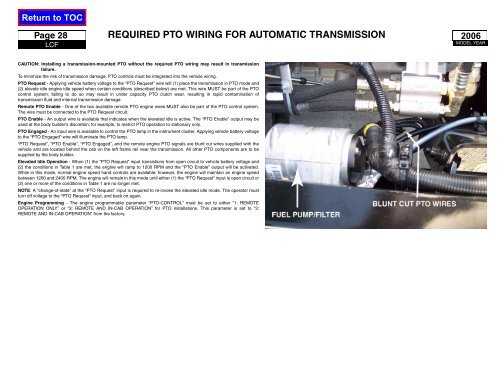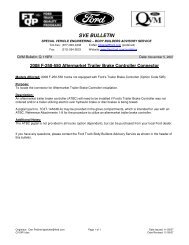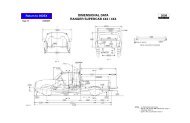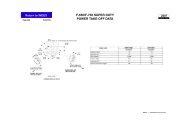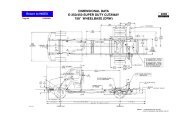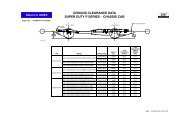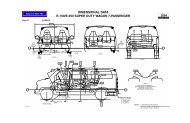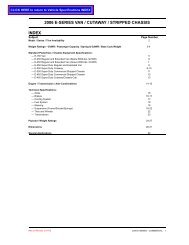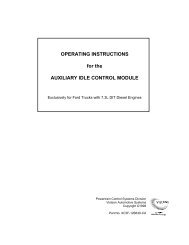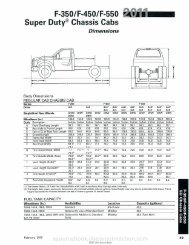2006 Ford LCF Low Cab Forward - Ford Fleet
2006 Ford LCF Low Cab Forward - Ford Fleet
2006 Ford LCF Low Cab Forward - Ford Fleet
Create successful ePaper yourself
Turn your PDF publications into a flip-book with our unique Google optimized e-Paper software.
Page 28<br />
<strong>LCF</strong><br />
REQUIRED PTO WIRING FOR AUTOMATIC TRANSMISSION<br />
CAUTION: Installing a transmission-mounted PTO without the required PTO wiring may result in transmission<br />
failure.<br />
To minimize the risk of transmission damage, PTO controls must be integrated into the vehicle wiring.<br />
PTO Request - Applying vehicle battery voltage to the “PTO Request” wire will (1) place the transmission in PTO mode and<br />
(2) elevate idle engine idle speed when certain conditions (described below) are met. This wire MUST be part of the PTO<br />
control system; failing to do so may result in under capacity PTO clutch wear, resulting in rapid contamination of<br />
transmission fluid and internal transmission damage.<br />
Remote PTO Enable - One of the two available remote PTO engine wires MUST also be part of the PTO control system.<br />
The wire must be connected to the PTO Request circuit.<br />
PTO Enable - An output wire is available that indicates when the elevated idle is active. The “PTO Enable” output may be<br />
used at the body builder’s discretion; for example, to restrict PTO operation to stationary only.<br />
PTO Engaged - An input wire is available to control the PTO lamp in the instrument cluster. Applying vehicle battery voltage<br />
to the “PTO Engaged” wire will illuminate the PTO lamp.<br />
“PTO Request”, “PTO Enable”, “PTO Engaged”, and the remote engine PTO signals are blunt cut wires supplied with the<br />
vehicle and are located behind the cab on the left frame rail near the transmission. All other PTO components are to be<br />
supplied by the body builder.<br />
Elevated Idle Operation - When (1) the “PTO Request” input transistions from open circuit to vehicle battery voltage and<br />
(2) the conditions in Table 1 are met, the engine will ramp to 1200 RPM and the “PTO Enable” output will be activated.<br />
While in this mode, normal engine speed hand controls are available; however, the engine will maintain an engine speed<br />
between 1200 and 2400 RPM. The engine will remain in this mode until either (1) the “PTO Request” input is open circuit or<br />
(2) one or more of the conditions in Table 1 are no longer met.<br />
NOTE: A “change-of-state” at the “PTO Request” input is required to re-invoke the elevated idle mode. The operator must<br />
turn off voltage to the “PTO Request” input, and back on again.<br />
Engine Programming - The engine programmable parameter “PTO-CONTROL” must be set to either “1: REMOTE<br />
OPERATION ONLY” or “3: REMOTE AND IN-CAB OPERATION” for PTO installations. This parameter is set to “3:<br />
REMOTE AND IN-CAB OPERATION” from the factory.<br />
<strong>2006</strong><br />
MODEL YEAR


